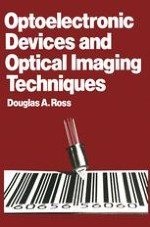1979 | OriginalPaper | Chapter
Solid State Photodetectors — The Photodiode and Phototransistor
Author : Douglas A. Ross
Published in: Optoelectronic Devices and Optical Imaging Techniques
Publisher: Macmillan Education UK
Included in: Professional Book Archive
Activate our intelligent search to find suitable subject content or patents.
Select sections of text to find matching patents with Artificial Intelligence. powered by
Select sections of text to find additional relevant content using AI-assisted search. powered by
This chapter discusses the two types of photodetector found most commonly in optoelectronic systems, the photodiode and phototransistor. Both devices are compact light detectors requiring no more than a few tens of volts for bias, and if made of silicon are responsive to light in-the visible and near infrared-wavelengths. Improved device technology has increased the sensitivity and bandwidth of the photodiode to the point where its performance is comparable with that of the photomultiplier tube, which is sensitive and fast enough to detect individual photons. The avalanche photodiode is particularly similar in performance to the photomultiplier tube. The photodiode finds application in the optically coupled isolator, optical data links, and in optical communications, where a fast response time is required for the very wide bandwidth expected of an optical communication system. The phototransistor, although somewhat more limited in bandwidth than the photodiode, finds numerous applications as a high-current response photodetector.
